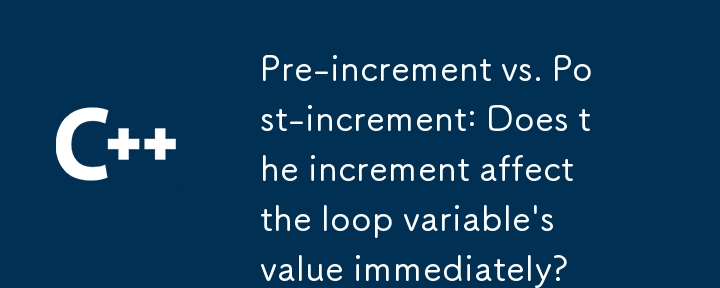

Understanding Pre-Increment and Post-Increment in Loops
Loops, such as for and while, are commonly used in programming to iterate through a block of code. When incrementing or decrementing a loop counter, developers have the option to use both pre-increment and post-increment operators.
Pre-Increment vs. Post-Increment
Impact on Iteration
The difference between pre-increment and post-increment becomes apparent when used within the loop:
Example:
while (true) {
//...
i++;
int j = i;
}Question: Will the variable j contain the original value of i or the incremented value of i at the end of the loop?
Answer:
In this example, the post-increment operator (i ) is used, which means that i is used with its original value, then incremented. Therefore, the variable j will contain the original value of i.
Usage in Calculations
The difference between pre-increment and post-increment becomes critical when the result is used in a calculation:
Example:
int j = i++; // i will contain i_old + 1, j will contain the i_old.
In this scenario, j will contain the original value of i, while i will be incremented by 1.
int j = ++i; // i and j will both contain i_old + 1.
In contrast, j and i will both contain the incremented value of i in this example.
By understanding the difference between pre-increment and post-increment, programmers can write more efficient and accurate code, ensuring that the loop counter behaves as expected.
The above is the detailed content of Pre-increment vs. Post-increment: Does the increment affect the loop variable\'s value immediately?. For more information, please follow other related articles on the PHP Chinese website!
 Which mobile phone models does Hongmeng OS 3.0 support?
Which mobile phone models does Hongmeng OS 3.0 support?
 A memory that can exchange information directly with the CPU is a
A memory that can exchange information directly with the CPU is a
 Dual graphics card notebook
Dual graphics card notebook
 The role of index.html
The role of index.html
 webstorm adjust font size
webstorm adjust font size
 webservice calling method
webservice calling method
 Introduction to carriage return and line feed characters in java
Introduction to carriage return and line feed characters in java
 Learn C# from scratch
Learn C# from scratch
 How to apply for registration of email address
How to apply for registration of email address




